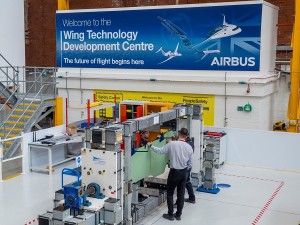Aerospace giant Airbus has opened a world-leading wing technology research and development centre at its Filton plant as it looks to develop the next generation of passenger aircraft.
The facility, which will be used to build and test demonstrators for a range of programmes and research projects, is the European’s group’s latest investment in the plant, where it employs more than 2,700 people.
Airbus said the Wing Technology Development Centre (WTDC) would help it accelerate the design, build and testing of wings by using the latest technology and world-leading demonstrators to further improve their performance.
Alongside engine optimisation, making wings longer, leaner and lighter is one of the biggest opportunities to improve fuel efficiency, reduce CO2 and ultimately work towards the aviation industry’s ambition to achieve net zero carbon emissions by 2050.
The WTDC adds to Airbus’ existing research and technology capability at the historic Filton plant, which has been behind countless aviation milestones over the years, from Concorde to the Airbus A380 superjumbo.
Two years ago Airbus opened the £40m Aerospace Integrated Research & Test Centre (AIRTeC) at the plant to work on the next generation of aircraft wing, landing-gear systems and fuel system designs.
Last year it launched a new Zero Emission Development Centre (ZEDC) to lead research into developing what Airbus calls a “cost-competitive cryogenic fuel system”.
The centre is part of Airbus’s efforts to have a zero-emission commercial aircraft in service by 2035 which is also deploying expertise from a specialist hydrogen technology centre on the Filton site.
Airbus Filton site head Sue Partridge, who also leads on its and Wing of Tomorrow (WoT) programme, said: “The new Wing Technology Development Centre will help us to ground our research in practicality.
“A key element of how we deliver technology for next generation aircraft wings is through WoT, our largest research and technology programme led by the team in the UK.”
The WTDC was officially opened a week after Airbus achieved a critical milestone in the programme when its second wing demonstrator was completed by at Broughton – Filton’s sister plant near Chester which manufactures wings.
The demonstrator has now been delivered to the WTDC and will be now prepared for structural testing in AIRTeC.
Airbus said the WoT programme was allowing it to explore new manufacturing and assembly technologies “so future generations can continue to benefit from flying”.
Sue Partridge added: “It’s about preparing our people, technology, industrial system, supply chain and digital and physical capabilities for next generation aircraft.
“We’re leveraging industry partners and the very best digital tools and automation to identify potential technology bottlenecks that may slow us down in the future.
“The foundations we lay now will help us build better and faster when the time comes.”
Half of the world’s air passengers fly on Airbus wings designed in Filton and manufactured in Broughton.
Industry experts believe the first wings developed in the WTDC will be used on future upgrades of Airbus’s best-selling A320 single-aisle family of airliners rather than totally new aircraft programmes.
The A320 family have around a 60% share of the short-haul market, beating arch US rival Boeing’s 737 range – at one time regarded as the workhorse of the low-cost airline sector.
Airbus’s three 17m full-scale wings demonstrators include:
- A static wing demonstrator used to test structural capabilities of new designs and materials and to validate our analysis.
- A fully equipped demonstrator used to test installation technologies and novel approaches to equipping the next generation of wings with systems.
- A ‘run@rate’ demonstrator, which will test industrial capability and automation technologies to assess how we can build wings at the scale and speed we need to.
Having developed the innovative wingtips used on Airbus’s energy-efficient A320neo (new engine option) family, Filton’s engineers are now deploying folding wingtip technology that looks at increasing the span of the wing to increase lift, reduce drag and to improve fuel efficiency without the need to alter existing airport infrastructure.





























